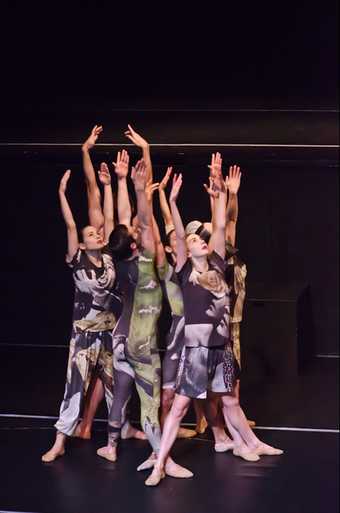I’ve had a photograph of Barbara Hepworth pinned on to my studio wall for more than a year now. It was taken in 1956 and shows her in fancy dress at the Penwith Arts Ball, accompanied by her close friend, the historian Frank Halliday. The ball was held at the St Ives Guildhall, decorated throughout to resemble a classical temple, lit with purple and blue lambent light.
Hepworth is dressed as the goddess Juno, and even though the Cornish town suffered the worst storm of the winter that day, she and Halliday seem to have escaped its wrath and pose resplendent in front of the camera. As I contemplate the photograph, I’m curious to know why she chose to dress as the goddess of love and marriage? Her ex-husband Ben Nicholson was at the ball, one of the few not in fancy dress. It used to be said that every man had his genius and every woman her equivalent juno; if ever a pair were set on embodying the two divinities, it was Hepworth and Nicholson.

Guests at the ‘Black and White’ Penwith Arts Ball, 1963
© St Ives Archive
I elected her as my juno after a very impressionable nocturnal visit to her garden and studio in St Ives in October 2009. Earlier the same day, with the support of all at Tate St Ives, I had created an ambitious new performance, Your Actions Are My Dreams, a collaboration in part with local Guise dancers and musicians. Robert Hunt, in his Popular Romances of the West of England, described these dancers in the 1860s as ‘a pantomimic representation or bal masque on an extensive scale’. In 2009 we took over the whole town.
I visited the garden at the invitation of Young Tate (now known at Tate Collective). As guests, we were encouraged to discover the sculptures purely through touch. Hepworth once said that every piece must be touched – that it was part of the way in which she made her work. So be it, Juno! Through stroking her sculptures in the dark, I fell in love after a lifetime of complete indifference to her work. Ever since that epiphany I’ve tried to maintain the same visceral relationship to her art. It helps me to find my way in.
Amid the foliage in Hepworth’s garden, I discovered Apollo, the delicate steel rod sculpture she had made for Michel Saint-Denis’s production of Electra at the Old Vic in 1951. She also created the costumes and a stark white set for the play. There is a photograph of Peggy Ashcroft, in her role as Electra, with her hands reaching out towards the elegant Apollo. The actress could easily have walked straight into the ‘Greeks & Romans’ Penwith Arts Ball five years later without even a costume change. Four years later, in 1955, Hepworth designed costumes and sets for Michael Tippett’s opera The Midsummer Marriage. The composer’s initial inspiration was purely visual, ‘a wooded hill-top with a temple’ where ‘Jung’s anima and animus’ could play. The sculptor responded with set designs that pared down her stringed sculptures into geometric planes of taut twine.
Hepworth’s relationship with Tippett, music and even her garden were shared with Priaulx Rainier, a figure often overlooked in the history of St Ives. Rainier had set up the St Ives Festival with Tippett and Hepworth in 1953, and had also, among other things, advised the sculptor on the design of her garden. The two women were close friends, although there is only one surviving photograph bearing witness to this. It shows Rainier dressed as a circus whip, next to Hepworth in Indian silks and sari. The Penwith Arts Ball had once more created a parade for the anima and animus of the great and the good living in the Cornish town in 1952.

Linder The ultimate form 2013, performance at St Ives Theatre February 2014
Ballet © Linder, Kenneth Tindall and Northern Ballet
Costumes © Richard Nicoll
Photo © Christina Birrer 2014
In 2012 I began to reflect upon Hepworth’s The Family of Man sculpture. It consists of nine standing figures, Ancestors I and II, Ultimate Form, Parent I and II, Youth, Young Girl, the Bridegroom and the Bride. The last of these was sent to the forge on my sixteenth birthday in 1970. At that time I was reading Germaine Greer’s The Female Eunuch and beginning to question the potential of a young girl and a youth liberated from the mores of society. In 2012 I worked with Northern Ballet to find answers to that ongoing enquiry. With Hepworth as our juno, we created The Ultimate Form ballet, taking her Bride, her Youth, her whole family of man and casting their archetypes forward in time while also looking back to where they’d come from. Invoking not so much Juno as Janus, a perfect costume for the 21st-century arts ball.
